The Painted Monasteries of Bucovina in Romania
Thursday, 2 August 2018I’ve been a regular visitor to Romania in recent years. Mauren and I were in Bucharest and Transylvania in 2014 and enjoyed it so much, particularly the beautiful Saxon villages of Transylvania, that we returned with a bunch of London friends for a second look in 2015. Then last year – on my little Bangkok to London driving trip – I found myself in Romania again as we crossed the Danube into Romania from Bulgaria and visited Timișoara, where the events which rapidly led to the overthrow of dictator Nicolae Ceaușescu kicked off. The 1989 Revolution Museum tells the grim tale.
This time I’m with Simon Calder, Travel Editor at The Independent in London, and we’re having a quick look around the beautiful painted monasteries of Bucovina. We fly in – Wizz Air from London Luton – to Suceava, another of those cities we’d never know existed if a low-cost carrier hadn’t decided to fly there.
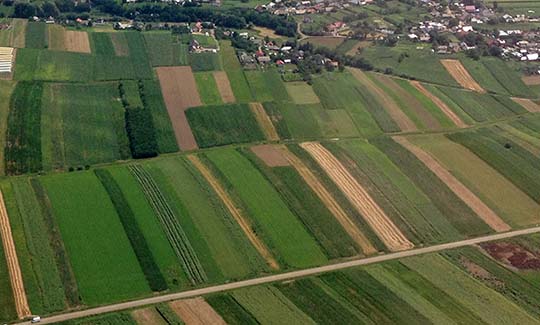
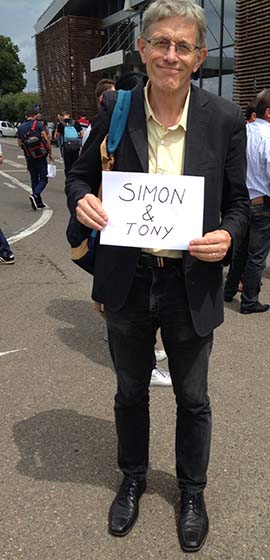 ▲ As we approach the town – north-east of Transylvania and not far south of Ukraine and west of Moldova – the fields are neat, multi-coloured strips. We’ve organized a guide-driver – Gabriel – to collect us at the airport and he comments that back in the Ceaușescu era, before the Soviet collapse, the fields would have all been the same mono-culture colour.
▲ As we approach the town – north-east of Transylvania and not far south of Ukraine and west of Moldova – the fields are neat, multi-coloured strips. We’ve organized a guide-driver – Gabriel – to collect us at the airport and he comments that back in the Ceaușescu era, before the Soviet collapse, the fields would have all been the same mono-culture colour.
◄ Simon – holding up our ‘welcome to Suceava’ sign
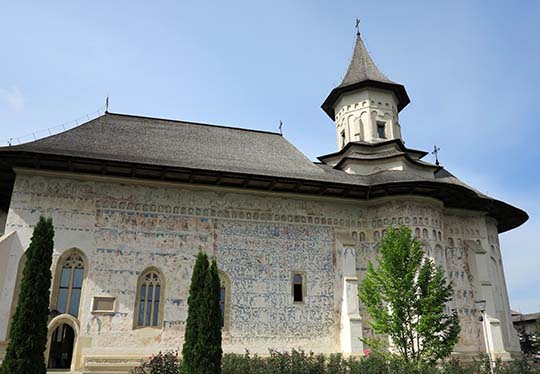 ▲ The painted monasteries date from the 15th and 16th century, they follow a standard Orthodox style, like the Probata Monastery. Although it’s not on the standard Bucovina monastery loop or as well preserved as other monasteries it did set the style that the others would follow. The sturdy defensive fall around the monastery is an indicator of the ongoing struggle between Orthodox Christianity and the Muslim Ottoman Empire at the time.
▲ The painted monasteries date from the 15th and 16th century, they follow a standard Orthodox style, like the Probata Monastery. Although it’s not on the standard Bucovina monastery loop or as well preserved as other monasteries it did set the style that the others would follow. The sturdy defensive fall around the monastery is an indicator of the ongoing struggle between Orthodox Christianity and the Muslim Ottoman Empire at the time.
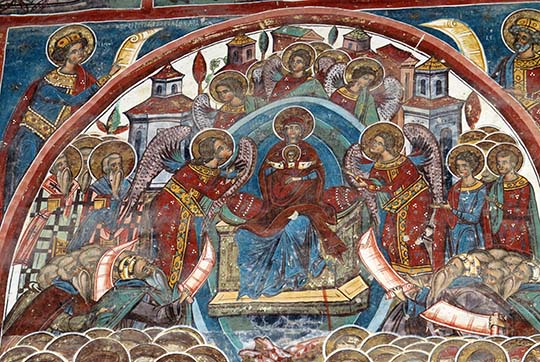 ▲ It’s the remarkably well-preserved paintings on the external walls of the monasteries which are so notable. They’re generally better preserved on one side than the other although it’s prevailing winds and weather which fade the paintings, not sunlight. This is the Humor monastery with its red-brown frescoes.
▲ It’s the remarkably well-preserved paintings on the external walls of the monasteries which are so notable. They’re generally better preserved on one side than the other although it’s prevailing winds and weather which fade the paintings, not sunlight. This is the Humor monastery with its red-brown frescoes.
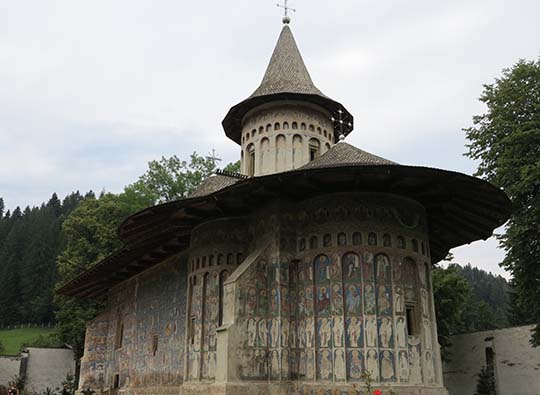 ▲ At Voroneț the signature colour is blue and it’s such a distinct shade that it’s defined as ‘Voroneț Blue.’
▲ At Voroneț the signature colour is blue and it’s such a distinct shade that it’s defined as ‘Voroneț Blue.’
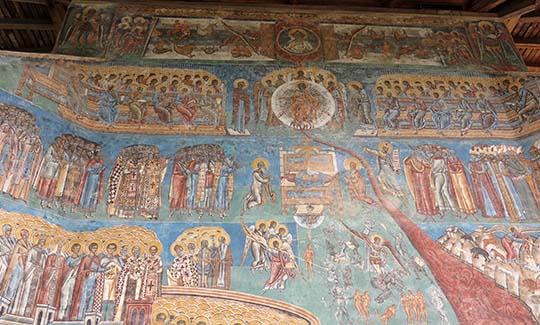 ▲ The Last Judgement fresco utilizes the entire western end of the monastery and is rated as the best fresco of any of the Bucovina Monasteries. In fact the frescoes inside the monasteries are, of course, better preserved that the exterior paintings, but no photography is allowed inside.
▲ The Last Judgement fresco utilizes the entire western end of the monastery and is rated as the best fresco of any of the Bucovina Monasteries. In fact the frescoes inside the monasteries are, of course, better preserved that the exterior paintings, but no photography is allowed inside.
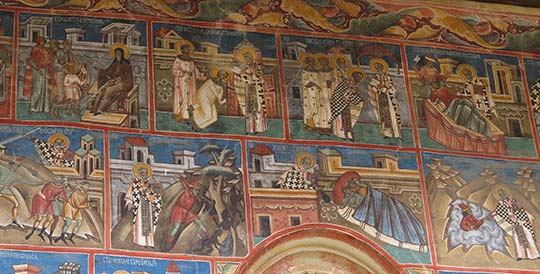 ▲ Beautiful frescoes, and in that unique blue colour, on the northern wall of the Voroneț Monastery.
▲ Beautiful frescoes, and in that unique blue colour, on the northern wall of the Voroneț Monastery.
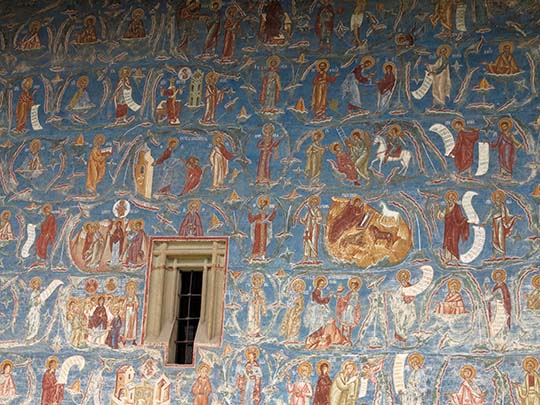 ▲ A family tree, Biblical geneaology detailed at Voroneț.
▲ A family tree, Biblical geneaology detailed at Voroneț.
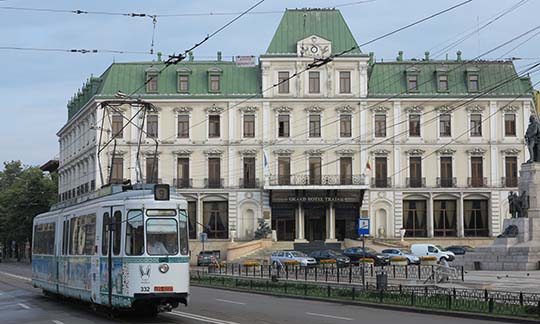
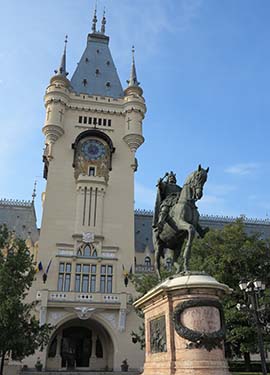 ▲ We spent the night in Iași (pronounced ‘yass’), the largest city in the Moldavia region and the second largest, after the capital Bucharest, in Romania. A tram rolls by the Grand Hotel Traian in Piaţa Unirii.
▲ We spent the night in Iași (pronounced ‘yass’), the largest city in the Moldavia region and the second largest, after the capital Bucharest, in Romania. A tram rolls by the Grand Hotel Traian in Piaţa Unirii.
◄ The next morning we had time to check the imposing Palace of Culture, fronted by a statue of Stephen the Great, before we departed Moldavia on a bus to the neighbouring country of Moldova. There are two names bound to cause confusion!






